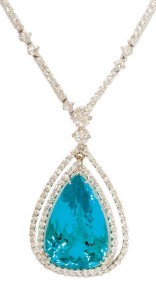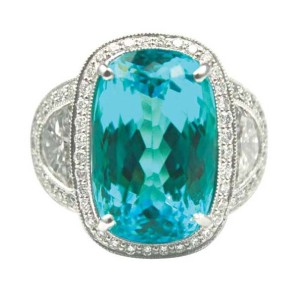Copper content

Normally, tourmaline owes it various colours to the presence of iron, manganese, chrome, and vanadium. However, it is copper that gives Paraiba tourmaline the vibrant blue-green appearance everyone is familiar with, although manganese may be present and thought to impact colour. The interplay between these two elements gives rise to a variety of fascinatingly beautiful colours: emerald green, turquoise to sky blue, sapphire blue, indigo, bluish-violet, and purple. Yet, it is the electric blue-green colour that is held in highest esteem, as it is not seen in any other gem variety. This unique colour has helped gemstones from this particular source break all market records and write a whole new chapter in tourmaline history.
U.S. designer Brian Cook deals only with Paraiba tourmaline from Mina da Batalha, as he believes the colour to be more saturated than stones that come from mines in other parts of Brazil, as well as Mozambique and Nigeria. According to Cook, Mozambique produces very nice paraiba tourmaline, although it is generally priced lower than its Brazilian counterpart.

Various studies conducted by a few laboratories specializing in coloured stones have shown that chemical fingerprinting through Laser Ablation Inductively Coupled Plasma Mass Spectrometry (LA-ICP-MS) can be useful for distinguishing copper-bearing tourmaline from the various localities based on the measurement of trace elements. Geochemical plots show that Nigerian tourmaline contains larger amounts of the trace elements gallium, germanium, and lead, whereas the Brazilian variety is rich in zinc, magnesium, and antimony. Mozambique samples indicate higher contents of beryllium, scandium, gallium, lead, and bismuth, although no magnesium is present.
Heat is commonly applied to paraiba tourmaline to improve or change colour. Although evidence of heat is typically not discernible by microscopy (except for features like tension cracks along growth tubes), visible spectroscopy may indicate the stone has been treated. However, the criteria used by most laboratories to identify heat treatments are still not conclusive to positively distinguish treated stones from untreated.





